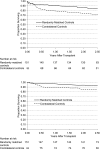The role of procurement biopsies in acceptance decisions for kidneys retrieved for transplant
- PMID: 24558053
- PMCID: PMC3944771
- DOI: 10.2215/CJN.07610713
The role of procurement biopsies in acceptance decisions for kidneys retrieved for transplant
Abstract
Background and objectives: There is a shortage of kidneys for transplant, and many patients on the deceased donor kidney transplant waiting list would likely benefit from kidneys that are currently being discarded. In the United States, the most common reason given for discarding kidneys retrieved for transplant is procurement biopsy results. This study aimed to compare biopsy results from discarded kidneys with discard attributed to biopsy findings, with biopsy results from comparable kidneys that were successfully transplanted.
Design, setting, participants, & measurements: In this retrospective, observational, case-control study, biopsy reports were examined from 83 kidneys discarded in 2010 due to biopsy findings (cases), 83 contralateral transplanted kidneys from the same donor (contralateral controls), and 83 deceased donors randomly matched to cases by donor risk profile (randomly matched controls). A second procurement biopsy was obtained in 64 of 332 kidneys (19.3%).
Results: The quality of biopsy reports was low, with amounts of tubular atrophy, interstitial inflammation, arteriolar hyalinosis, and acute tubular necrosis often not indicated; 69% were wedge biopsies and 94% used frozen tissue. The correlation between first and second procurement biopsies was poor; only 25% of the variability (R(2)) in glomerulosclerosis was explained by biopsies being from the same kidney. The percentages of glomerulosclerosis overlapped substantially between cases, contralateral controls, and randomly matched controls: 17.1%±15.3%, 9.0%±6.6%, and 5.0%±5.9%, respectively. Of all biopsy findings, only glomerulosclerosis>20% was independently correlated with discard (cases versus contralateral controls; odds ratio, 15.09; 95% confidence interval, 2.47 to 92.41; P=0.003), suggesting that only this biopsy result was used in acceptance decisions. One-year graft survival was 79.5% and 90.7% in contralateral and randomly matched controls, respectively, versus 91.6% among all deceased donor transplants in the Scientific Registry of Transplant Recipients.
Conclusions: Routine use of biopsies could lead to unnecessary kidney discards.
Figures




Comment in
-
Procurement biopsies in kidneys retrieved for transplantation.Clin J Am Soc Nephrol. 2014 Mar;9(3):443-4. doi: 10.2215/CJN.00470114. Epub 2014 Feb 20. Clin J Am Soc Nephrol. 2014. PMID: 24558052 Free PMC article. No abstract available.
References
-
- Matas AJ, Smith JM, Skeans MA, Lamb KE, Gustafson SK, Samana CJ, Stewart DE, Snyder JJ, Israni AK, Kasiske BL: OPTN/SRTR 2011 Annual Data Report: Kidney. Am J Transplant 13[Suppl 1]: 11–46, 2013 - PubMed
-
- Hopfer H, Kemény E: Assessment of donor biopsies. Curr Opin Organ Transplant 18: 306–312, 2013 - PubMed
-
- Rao PS, Schaubel DE, Guidinger MK, Andreoni KA, Wolfe RA, Merion RM, Port FK, Sung RS: A comprehensive risk quantification score for deceased donor kidneys: The kidney donor risk index. Transplantation 88: 231–236, 2009 - PubMed
-
- Leppke S, Leighton T, Zaun D, Chen SC, Skeans M, Israni AK, Snyder JJ, Kasiske BL: Scientific Registry of Transplant Recipients: Collecting, analyzing, and reporting data on transplantation in the United States. Transplant Rev (Orlando) 27: 50–56, 2013 - PubMed
-
- Hollander M, Wolfe DA: Nonparametric Statistical Methods, 2nd Ed., New York, John Wiley & Sons, 1999
Publication types
MeSH terms
Grants and funding
LinkOut - more resources
Full Text Sources
Other Literature Sources
Medical

